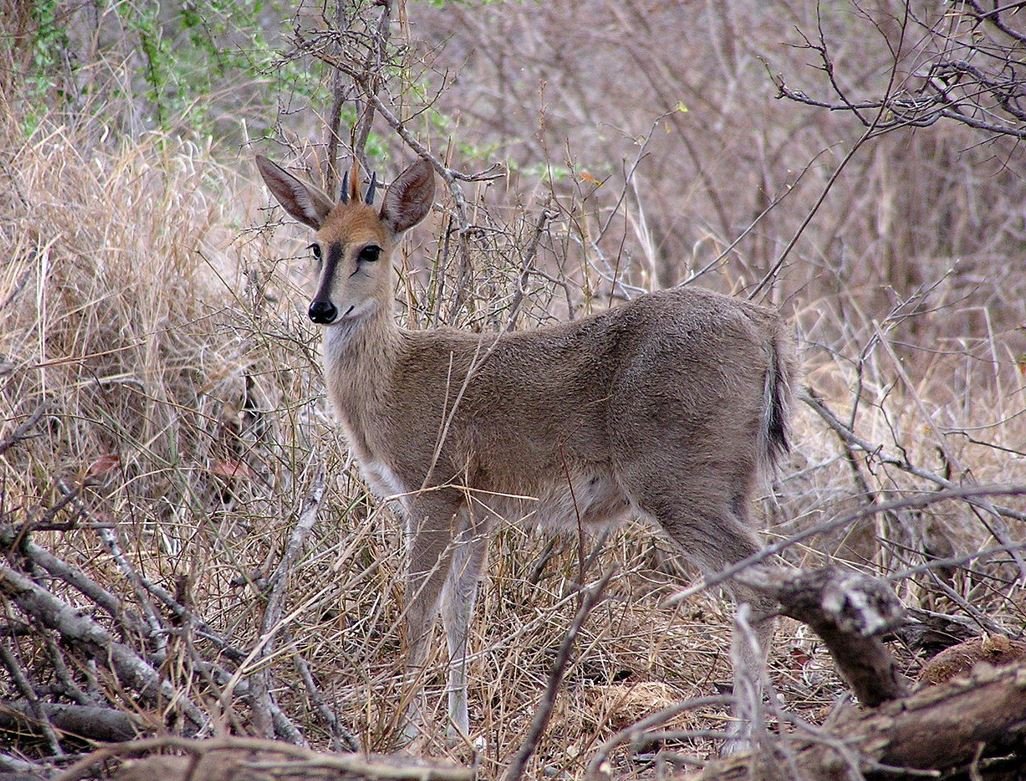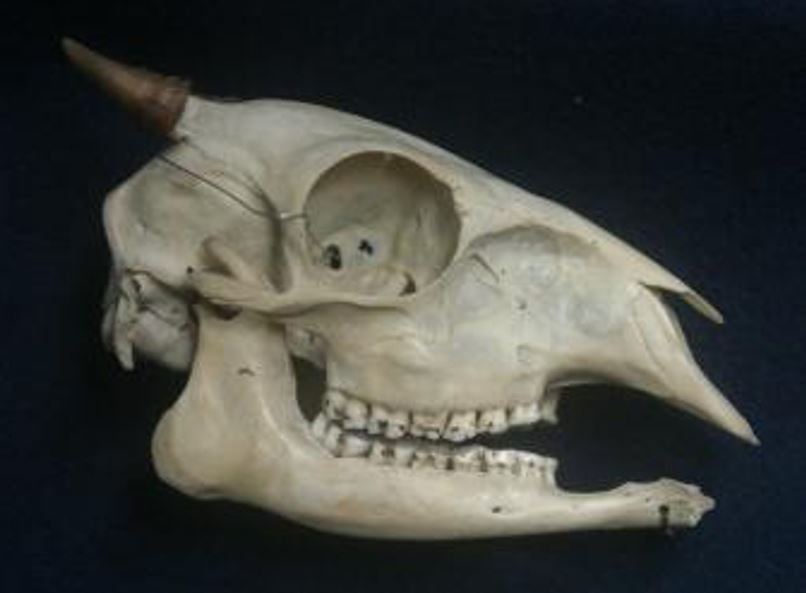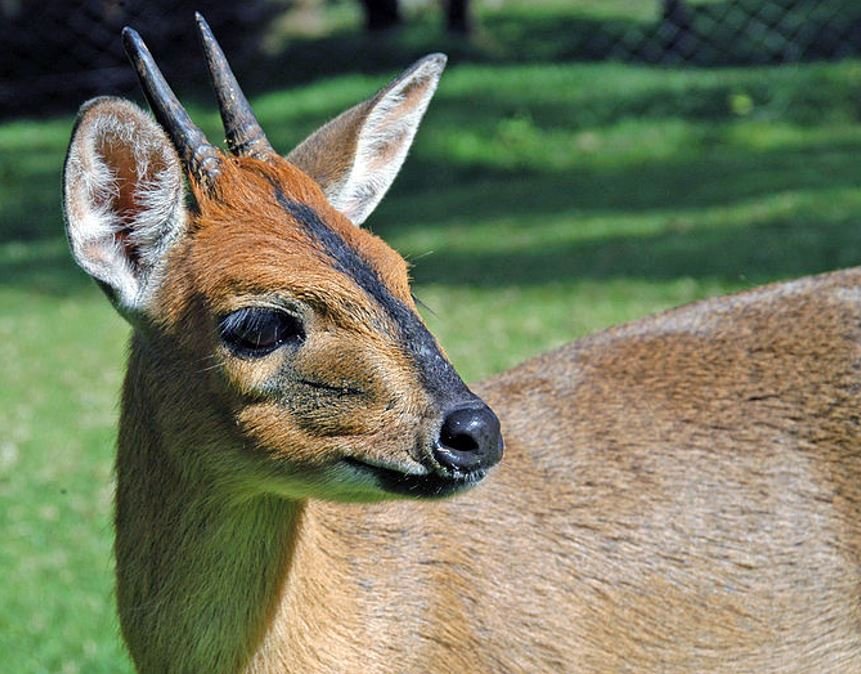It’s time to look at duikers. Again.
Time for another classic from the archives. This article originally appeared on Tet Zoo ver 2 back in August 2008, then reappeared in tweaked, updated form in 2014… aaand is here provided once more for a brand-new audience! Ok, let’s go...
Caption: Philip Sclater’s 1894 illustration of Maxwell’s duiker Philantomba maxwellii from his The Book of Antelopes. Image: public domain.
Duikers or cephalophines are an entirely African group of bovids, and so far as we know they have never gotten out of Africa. Virtually nothing is known of their early history. There’s a partial maxilla and a molar from the Miocene, and a few Pliocene and Pleistocene records, some of which are of extant species. The Miocene molar is interesting as it’s from northern Africa, where no duikers occur today. However, Manlius (2001) suggested that an animal depicted in a 4th dynasty hunting scene (dating to c. 2561-2459 BCE) at Atet’s tomb in Meidum, Egypt, is a Jentink’s duiker Cephalophus jentinki, and proposed on the basis of this that an isolated population of this species might have persisted in Egypt until at least this time. Flores (2001) pointed out that duiker bones were identified from an Egyptian tomb in 1948, perhaps providing support for this idea. Given the present range of C. jentinki (Sierra Leone, Liberia, Ivory Coast), a purported presence in ancient Egypt is very difficult to believe, but maybe these discoveries do show that duikers did occur north of the Sahara until recently [UPDATE: I have been reminded – see comments below – that the animal in the image has been reidentified as the calf of an Addax Addax nasomaculatus!].
Duiker phylogeny: four main lineages. Phylogenetic work indicates that duikers belong to four distinct lineages. Maxwell’s duiker Philantomba maxwellii and the Blue duiker P. monticola – together sometimes called the dwarf duikers, blue duikers or the ‘conservative dwarfs’ – seem to form a clade that is the sister-group to all other duikers. They differ from the others in lacking inguinal glands, in having an untufted tail and in other features. They were generally lumped into Cephalophus for much of the latter part of the 20th century, but the view that they deserve their own genus – Philantomba – is now popular again (the name was first published in 1840), and the distinct status and monophyly of this lineage has been supported by most authors who have worked on duiker phylogeny and systematics in recent years (Jansen van Vuuren & Robinson 2001, Colyn et al. 2010, Johnston & Anthony 2012, Bibi 2013). A distinct duiker of this sort, recognised in a market in Benin in November 2003, eventually led to the recognition of a third Philantomba species: Walter’s duiker P. walteri (Colyn et al. 2010).
Caption: the Natural History Museum at Tring (the Walter Rothschild Museum) features this amazing case of duikers, possibly the most ‘complete’ collection of taxiderm duikers on display anywhere in the world (correct me if this claim is wrong!). Several of the specimens are very much light-damaged relative to their original colours and patterns (more on this below). Image: Darren Naish.
A widespread and very successful savannah specialist (the Bush duiker, Grey duiker, Common duiker or Grimm’s duiker Sylvicapra grimmia: over 40 subspecies have been named) forms the sister-taxon to a combined giant duiker and red duiker clade in some studies (Jansen van Vuuren & Robinson 2001) and to the giant duikers alone in others (Johnston & Anthony 2012). The phylogenetic position of the Zebra duiker and Ader’s duiker C. adersi is uncertain and they may represent distinct lineages within the giant duiker + red duiker clade.
Caption: skull of Maxwell's duiker Philantomba maxwellii, showing the proportionally short muzzle and tiny horns of this bovid group. Image: (c) University of Edinburgh, from here.
Duikers: a mostly young evolutionary radiation. The duiker group as a whole contains about 20 species and a substantially greater number of subspecies, and appears to have occurred rapidly and recently (post-Miocene). Indeed, the amount of divergence between the major lineages is relatively minor. Johnston & Anthony (2012) argued that the four main lineages diverged in the Miocene and/or Pliocene, but that species-level divergences within those lineages happened in the Pleistocene.
The exact placement of duikers within Bovidae is uncertain but they’re almost certainly antilopines close to gazelles, dwarf antelopes, klipspringers and so on (Hassanin & Douzery 1999a, b, Price et al. 2005, Bibi 2013). Their small size and ‘slinker’ ecomorphotype (read on) have generally led to the assumption that they're primitive. However, their complex brains, reduced horns, and shortened faces led Kingdon (1997) to suggest that they’re the dwarfed descendants of larger ancestors rather than primitive, and genetic and fossil data suggest that they’re a young group, as we’ve seen. Indeed, there are no indications from their phylogenetic position, genetics or fossil record that they’re more than 10 million years old (Johnston & Anthony 2012, Bibi 2013). They are not, so far as we can tell, ancient, late-surviving relicts of an earlier stage in bovid evolution or anything like that.
Caption: Common duiker in profile (don't ask which subspecies: I assume it's the nominate one). Image in public domain.
Ranging in size from about 4 to about 80 kg, duikers include diurnal, cathemeral and nocturnal species (cathemeral animals are active at any hour). Mostly forest dwellers, they also include savannah species as well as taxa that frequent montane environments (Ruwenzori duiker C. rubidus) and swamps (Black-fronted duiker C. nigrifrons). Some species have been reported to climb on sloping tree trunks. Most species are coloured in reds and browns but some are blackish.
Caption: beautiful, boldly patterned Jentink's duiker, one of the largest member of the group (it and the Yellow-backed duiker are both said to be the largest depending on which source you consult). Image (c) Brent Huffman, from Ultimate Ungulate.
Jentink’s duiker, one of the largest member of the group, has a black head and neck, a white collar over the shoulders, and a grizzled grey body. Despite its size and striking appearance, it wasn’t scientifically discovered until 1884 and not named until 1892. Reddish crests that virtually conceal the small, posteriorly placed horns are common. Apparently, duikers have enormous hearts, these being about twice as large, proportionally, as those of humans (Ralls 1973).
Caption: more detailed view of the duiker case at the Natural History Museum at Tring (the Walter Rothschild Museum) to emphasise the massive difference in appearance between the Yellow-backed duiker (front right) and the live animal (as shown above). A good example of what several decades on display can do to a dark-hued animal specimen. Image: Darren Naish.
Duikers are what is known as slinkers: mostly small-bodied, they rely on concealment and rapid acts of explosive saltation to avoid and escape predators, they are highly territorial, monogamous, and with sexes that (generally) are similarly sized* and similarly armed (slinking has also been termed the ‘microcursorial adaptive syndrome’, but that ain’t so catchy). The ability of duikers to dive rapidly into deep cover explains their common name (it’s Afrikaans for diver). It’s apparently pronounced like ‘biker’, and not ‘doy-kah’ as I’ve been saying for the last few decades. Duikers possess large preorbital (or maxillary) glands as well as pedal glands and (in some) inguinal (= groin) glands, and they frequently mark objects in their territory, in some cases doing so about every 10 minutes. The preorbital glands are obvious in some of the photos used here.
* Female duikers are often up to 4% bigger than males.
Caption: Blue duiker portrait. The Blue duiker is a widespread species, occurring in two major disjunct populations (one occurring east to west across central Africa and one in the far south). These have been split into around 12 subspecies. Image: derekkeats, CC BY SA 2.0.
Food and feeding. Like all slinkers, duikers specialise on high quality food like leaves and fruits, and fungi and bark are also eaten. They also eat insects and carrion, and regularly kill and eat frogs, small mammals, lizards, and birds. That’s right: omnivorous bovids. Ants were found to make up over 10% of the stomach contents (dry weight) of Blue duiker (Ronald & Kranz 2001) and captive animals are fed dog food in addition to plants (Nowak 1999). Some duiker species have been reported to sometimes toy with prey in the same way that domestic cats do.
Caption: cameratrap image of an Abbot's duiker with a frog in its mouth, of course. Image (c) Francesco Rivero, this version from Ultimate Ungulate.
In Angola, people believe that the Yellow-backed duiker C. sylvicultor eats the meat of Bell’s hinge-backed tortoise Kinixys belliana by forcibly blasting the tortoise’s body out of the shell (Lumpkin & Kranz 1984). I don’t think this is true but wish it was. The photo shown above – from Rovero et al. (2005) – shows an Abbott’s duiker C. spadix photographed in the Udzungwa Mountains of southern Tanzania. This is one of the first photos ever taken of this species in the wild (Rovero et al. 2005), and shows the duiker eating a frog (possibly a Tanzanian torrent frog Arthroleptis yakusini). Since this photo was taken, cameratrap and DNA data collected from dung has demonstrated the presence of three additional populations of the species in the Udzungwa Mountains (Jones & Bowkett 2012), so it’s known to be more widely distributed than used to be thought.
Caption: a section of bovid phylogeny from Bibi (2013), showing that duikers (Cephalophini) are close to klipspringers (Oreotragus) and Antilopini, the clade that include dik-diks and gazelles. Authors differ as to whether they treat the various names shown here as 'subfamilies' or 'tribes' or whatever.
While duikers might seem like the sort of mammals that would usually be regarded as ‘less advanced’ than the big, noble antelopes that live out on the sunny plains (and, indeed, some workers have interpreted things this way), there are indications from duiker anatomy and behaviour that they are actually among the smartest and most complex of bovids: if you like, the ‘most advanced’. Their brains are large and complex and are said to be the biggest (proportionally) of all the bovids (hypothesis: has their evolution been driven by paedomorphosis?). A relatively long gestation and slow growth rate may be consequences of a prolonged learning period (Kingdon 1997), and it seems that duikers have to learn to predict and exploit the behaviour of herbivorous canopy animals, like monkeys, fruit bats and birds. The fruits that these animals drop are eaten by the duikers.
Caption: Zebra duiker skin with my hand for scale. This specimen briefly masqueraded as a potential thylacine skin at a cryptozoology conference. Image: Darren Naish.
Spinage (1986) wrote about a Common duiker that he raised as a pet and later released into the wild. It then disappeared completely, until (two months later) a grass fire destroyed all the vegetation that the duiker would have been familiar with. The duiker now reappeared, standing in the open behind the house where it had been reared, looking dejected. In a charred and blackened environment, Spinage suggested that the duiker had returned to the only familiar place. He petted it, and it went away, but when seen again on later occasions it would run up to him and stand to be stroked (Spinage 1986, p. 134).
A future for duikers? What does the future hold for this fascinating group of little antelopes? Things are not altogether good, since evidence suggests that duikers are being harvested at unsustainable rates for the bushmeat trade; some species have been severely depleted from parts of their range as a consequence (van Vliet et al. 2007). Several studies have examined the impact of hunting on duiker populations: some emphasise how difficult it is to reasonably assess the rate and impact of hunting, given the many poorly understood and poorly monitored variables (van Vliet & Nasi 2008). There are also indications that hunting in some places is only a problem when its intensity is focused due to a concentration of people brought about by road construction through the forest: when people are not so concentrated their hunting forays occur over much wider areas, resulting in perhaps sustainable levels of predation on duikers (Yasuoka 2006). Whatever, several duiker species are endangered and it seems unlikely that they will persist into the future given current rates of exploitation. Indeed, most species are now regarded as being at risk.
Caption: numerous animals are being killed at unsustainable rates across Africa for the bushmeat and fetish trades. This photo (from Colyn et al. 2010) shows numerous species encountered in a market; the four duiker heads in the middle belong to the then-brand-new Walter’s duiker.
For more on pecoran artiodactyls at TetZoo, see…
Stuffed megamammal week, day 1: Khama, April 2009
Stuffed megamammal week, day 2: Eland, April 2009
The many magnificent subspecies of Argali, February 2011
The ‘Great bubalus’ in ancient African rock art, April 2011
The monster sheep that wasn’t, and other tales of African Bovini, May 2011
Reasons for really liking wildebeest, February 2014
The Pronghorn Antelope: Designed by Committee, March 2014
Release the Fossil Pronghorns!!, November 2021
This blog benefits from your support. Thank you to those who help via patreon!
Refs – -
Colyn, M., Hulselmans, J., Sonet, G., Oude, P., de Winter, J., Natta, A., Tamás Nagy, Z. & Verheyen, E. K. 2010. Discovery of a new duiker species (Bovidae: Cephalophinae) from the Dahomey Gap, West Africa. Zootaxa 2637, 1-30.
Flores, D. V. 2001. More about duikers in ancient Egypt. Science 292, 440.
Hassanin, A. & Douzery, J. P. 1999a. Evolutionary affinities of the enigmatic saola (Pseudoryx nghetinhensis) in the context of the molecular phylogeny of Bovidae. Proceedings of the Royal Society of London B 266, 893-900.
- . & Douzery, J. P. 1999b. The tribal radiation of the family Bovidae (Artiodactyla) and the evolution of the mitochondrial cytochrome b gene. Molecular Phylogenetics and Evolution 13, 227-243.
Jansen van Vuuren, B. & Robinson, T. J. 2001. Retrieval of four adaptive lineages in duiker antelope: evidence from mitochondrial DNA sequences and fluorescence in situ hybridization. Molecular Phylogenetics and Evolution 20, 409-425.
Jones, T. & Bowkett, A. E. 2012. New populations of an Endangered Tanzanian antelope confirmed using DNA and camera traps. Oryx 46, 14-15.
Kingdon, J. 1997. The Kingdon Field Guide to African Mammals. Academic Press, San Diego.
Lumpkin, S. & Kranz, K. R. 1984. Cephalophus sylvicultor. Mammalian Species 225, 1-7.
Manlius, N. 2001. Were there duikers in ancient Egypt? Science 291, 1701.
Nowak, R. M. 1999. Walker’s Mammals of the World, Sixth Edition. Volume II. The Johns Hopkins University Press, Baltimore and London.
Price, S. A., Bininda-Emonds, O. R. P. & Gittleman, J. L. 2005. A complete phylogeny of the whales, dolphins and even-toed hoofed mammals (Cetartiodactyla). Biological Reviews 80, 445-473.
Ralls, K. 1973. Cephalophus maxwelli. Mammalian Species 31, 1-4.
Ronald. K. & Kranz, K. 2001. Duikers. In MacDonald, D. (ed) The New Encyclopedia of Mammals. Oxford University Press (Oxford), pp. 542-545.
Rovero, F., Jones, T. & Sanderson, J. 2005. Notes on Abbott’s duiker (Cephalophus spadix True 1890) and other forest antelopes of Mwanihana Forest, Udzungwa Mountains, Tanzania, as revealed by camera-trapping and direct observations. Tropical Zoology 18, 13-23.
Spinage, C. A. 1986. The Natural History of Antelopes. Christopher Helm, London.

















